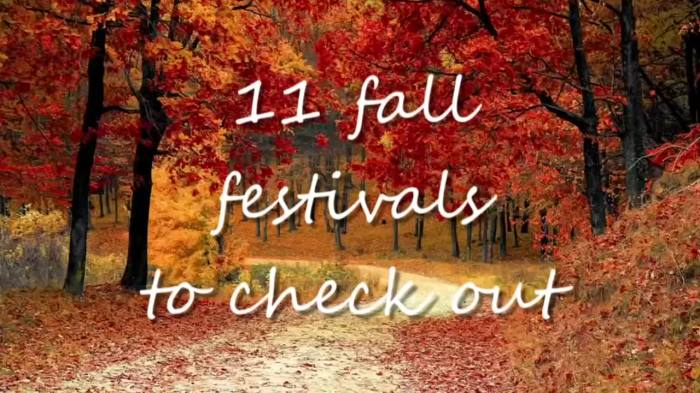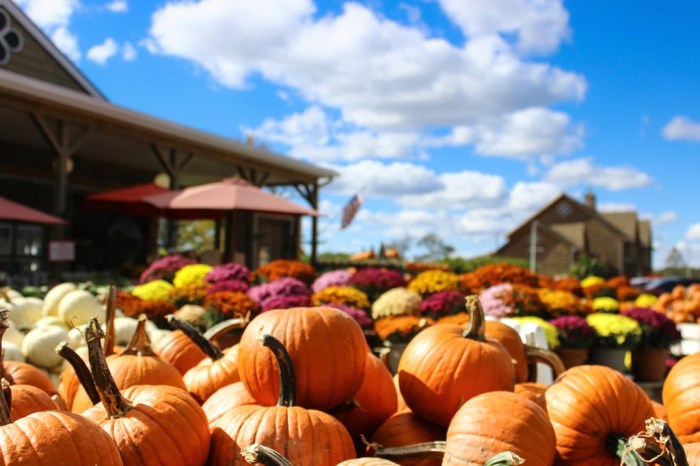Fall Festivals Today offer a vibrant tapestry of autumnal delights across the nation. From the crisp air of New England’s harvest celebrations to the spirited pumpkin patches of the Midwest and the soulful sounds of Southern gatherings, these festivals represent a unique blend of community, tradition, and economic vitality. This guide delves into the diverse landscape of fall festivals, exploring their regional variations, economic impact, and the captivating experiences they offer.
We’ll examine the different types of festivals, from traditional harvest celebrations to thrilling haunted attractions, highlighting the key activities and entertainment that draw millions each year. Discover how these events boost local economies, support farmers and businesses, and create unforgettable memories for participants. Get ready to immerse yourself in the sights, sounds, and flavors of fall festivals across America.
Types of Fall Festivals

Fall festivals are a vibrant tapestry of community celebrations, offering a diverse range of experiences that capture the essence of the autumn season. From the simple joy of picking pumpkins to the thrilling chills of haunted attractions, these events cater to a wide spectrum of interests and age groups, driving significant economic activity and fostering a sense of community spirit.
Understanding the different types of fall festivals is key to maximizing your enjoyment and potentially even leveraging them for business opportunities.
Fall festivals can be broadly categorized, though many events often blend elements from multiple categories. This creates a unique and ever-evolving landscape of autumnal celebrations. The core categories include harvest festivals, craft fairs, pumpkin patches, and haunted attractions, each with its own distinct character and appeal.
Harvest Festivals
Harvest festivals celebrate the culmination of the agricultural year, showcasing the bounty of the fall harvest. These events often feature displays of locally grown produce, farmers’ markets, cooking demonstrations, and competitions centered around the harvest. The Apple Butter Frolic in Ohio, for instance, is a prime example, featuring apple butter making demonstrations, live music, and craft vendors, celebrating the region’s rich agricultural heritage.
Similarly, the annual Harvest Festival in Napa Valley focuses on the region’s renowned wine harvest, with wine tastings, vineyard tours, and gourmet food experiences. These festivals provide a direct connection to the land and its products, offering a tangible experience of the season’s abundance.
Craft Fairs
Craft fairs showcase the artistry and skill of local artisans and craftspeople. These events are a treasure trove of unique, handcrafted items, from pottery and jewelry to textiles and woodwork. The renowned Renegade Craft Fair, with locations across the United States, provides a platform for independent makers to sell their wares and connect with consumers. These fairs are not just shopping experiences; they offer a glimpse into the creative process, allowing attendees to engage directly with the artists and learn about their techniques.
The emphasis on handmade goods makes them attractive to consumers seeking unique, high-quality items, and provides economic opportunities for the participating artisans.
Pumpkin Patches
Pumpkin patches are quintessential fall experiences, offering families a chance to select their own pumpkins directly from the field. Beyond pumpkin picking, many patches include additional activities like hayrides, corn mazes, and petting zoos, creating a full-day experience for families and creating memorable fall moments. Many farms, like those in the New England region, offer this complete fall experience, making it a popular family outing.
These destinations offer a rustic charm, providing a respite from urban life and a chance to connect with nature. The experience is often enhanced by the scenic beauty of the autumn landscape, adding to the overall appeal.
Haunted Attractions
Haunted attractions cater to thrill-seekers, offering a dose of spooky fun during the Halloween season. These range from elaborate haunted houses with elaborate sets and scare actors to smaller, community-based events. Examples include the widely known Knott’s Scary Farm in California or local haunted hayrides found across the country. These attractions provide a unique form of entertainment, tapping into the human fascination with the supernatural and the thrill of a good scare.
The elaborate theming and special effects create immersive experiences that are both exciting and memorable.
The common themes and activities found across various fall festival types are numerous and often overlap.
- Seasonal Produce: Apples, pumpkins, gourds, and other fall harvests are frequently featured.
- Craft Vendors: Handmade goods, often reflecting fall themes, are a common sight.
- Live Entertainment: Music, dance, and theatrical performances often enhance the festive atmosphere.
- Family-Friendly Activities: Hayrides, corn mazes, petting zoos, and pumpkin carving are popular attractions.
- Food and Drink: Seasonal treats, such as apple cider, pumpkin pie, and other autumnal delights, are widely available.
Visual Representation of Fall Festivals: Fall Festivals Today

Fall festivals are more than just events; they’re immersive experiences meticulously crafted through visual storytelling. The success of a fall festival hinges significantly on its visual appeal, creating a captivating atmosphere that draws attendees in and leaves them with lasting memories. A well-executed visual strategy transforms a simple gathering into a truly memorable occasion.The visual elements of a fall festival work in harmony to evoke the spirit of autumn.
Think vibrant color palettes, carefully chosen decorations, and engaging costumes—all contributing to an overall sensory experience. Lighting plays a crucial role in setting the mood, transforming the festival grounds into a magical realm. Let’s delve into the specific elements that contribute to this compelling visual narrative.
Color Palettes and Decorative Elements
The color scheme of a fall festival is intrinsically linked to the season. Warm, earthy tones dominate, reflecting the changing leaves and the harvest. Think rich oranges, deep reds, golden yellows, and browns. These colors are often seen in everything from the festival banners and signage to the clothing of attendees and the food being served. Pumpkins, gourds, corn stalks, and hay bales are common decorative elements, adding texture and reinforcing the autumnal theme.
The strategic placement of these elements—perhaps lining pathways or creating thematic displays—further enhances the overall aesthetic. Consider the impact of a large, intricately carved pumpkin display versus a simple scattering of gourds; the former commands attention and elevates the visual experience.
Lighting and Ambiance, Fall Festivals Today
Lighting is instrumental in setting the mood and enhancing the atmosphere of a fall festival. Warm, amber-toned lighting, mimicking the glow of a setting sun, creates a cozy and inviting ambiance. String lights draped across trees or strung along pathways add a touch of magic, transforming the festival grounds into a twinkling wonderland. Strategic use of spotlights can highlight key features, such as a live music stage or a food vendor area, drawing attention and creating visual focal points.
The careful manipulation of light and shadow can even transform ordinary spaces into something extraordinary, adding depth and intrigue to the overall scene. For instance, backlighting a hay bale display can create a dramatic silhouette, adding an element of mystery and visual interest.
Costumes and Attendee Participation
Costumes play a significant role in the visual narrative of a fall festival. Attendees often embrace the theme by dressing in autumnal attire, perhaps wearing flannel shirts, sweaters, and boots. Some may even opt for more elaborate costumes, such as witches, scarecrows, or characters from folklore. This active participation from attendees adds another layer of visual richness and contributes to the overall festive atmosphere.
The diversity of costumes creates a vibrant and engaging spectacle, making the festival a visually captivating experience. The collective energy generated by these costumed participants contributes significantly to the festival’s overall energy and vibrancy.
Example of a Fall Festival Scene (Alternative Text for an Image)
A picturesque fall festival scene unfolds: golden sunlight filters through the vibrant foliage of maple and oak trees, casting dappled shadows on the bustling crowd. Rows of intricately carved pumpkins glow warmly under string lights strung between rustic wooden stalls overflowing with autumnal goods—hand-knitted scarves, homemade jams, and freshly baked pies. Attendees, clad in cozy sweaters and vibrant fall colors, mingle happily, children’s laughter echoing through the crisp air.
A lively bluegrass band plays on a makeshift stage adorned with corn stalks and hay bales, their music blending with the aroma of roasted nuts and spiced cider. The overall scene is one of warmth, community, and the joyous celebration of the harvest season.
Fall Festivals Today are more than just seasonal events; they are powerful economic engines, community builders, and vibrant expressions of cultural heritage. From the aroma of freshly baked goods to the lively sounds of music and laughter, these festivals offer a rich tapestry of experiences that leave lasting impressions. By understanding their regional nuances, economic contributions, and the captivating atmosphere they create, we can better appreciate the significant role they play in enriching our lives and communities.
So, plan your visit and experience the magic firsthand!